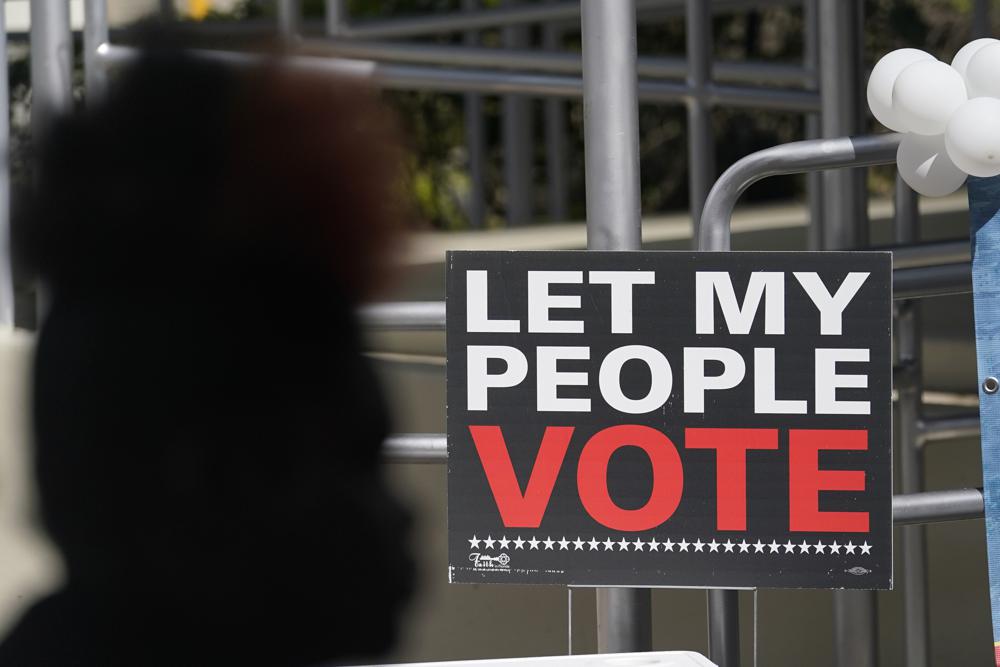Florida
Maya Brown: The Purge — Florida’s threat to democracy, communities of color

Life comes at you fast. It’s less than four months until Primary Election Day, and as the 2024 Elections loom large on the horizon like a Florida summer shower, the Sunshine State finds itself embroiled in a contentious battle over voting rights — again.
Like Groundhog’s Day, but instead of worrying about packing up the peacoats or pulling out the crop tops, it’s glaring red flags about democracy on the line.
The attack on voting rights, from Florida’s Capitol to the Governor’s Mansion and the 7-person Supreme Court isn’t new. Recent changes in state law have led to a surge in inactive registered voters and a disproportionate purge of names from vote-by-mail rolls, with communities of color bearing the brunt of the impact.
From group chats to bar conversations, the alarms about shifting voter registration statistics are valid.
However, it’s like the title of one of America’s poignant civil rights leaders’ last books, “Where Do We Go From Here? Chaos or Community.” It’s not just about who wins elections; this alarming trend threatens the very foundation of democracy and needs our attention — like six months ago.
“As goes Florida, so does the nation,” we’ve screamed cycle after cycle.
My home state has long been a battleground, but recent partisan legislative maneuvers have shifted races won and lost by less than one percentage point to a swing of a 20-point difference. Amendments to voting laws have introduced stringent criteria for maintaining active voter status — resulting in a staggering increase in the number of inactive registered voters.
Florida’s new laws, purportedly aimed at maintaining the integrity of the electoral system, have resulted in an unprecedented number of voters being labeled as inactive. Many of these individuals, predominantly from minority communities, already face barriers to participation in traditional voting methods.
Now, the intersections of transience and conflicting work schedules when polls are open make mail-in ballots a primary avenue for casting a ballot, but legislators just made it another hurdling task to remember to update your registration if you move and register to vote by mail every election.
Our civic duty to participate in our elections should be as convenient as it is to carry a concealed weapon without a permit. This isn’t a partisan issue — everyone should be concerned about the residual impacts of these blatant voter suppression tactics on registration and turnout.

In this climate of uncertainty, misinformation and voter apathy, we must take decisive action to make voter access easier. The key to winning this cycle? Reengage those affected by these discriminatory measures and who likely don’t even know it.
Getting an inactive voter to be active is a good 2-for-1 deal.
Voting by mail emerges as a crucial avenue for participation, offering convenience and accessibility to voters who may not know their registration is inactive, offering a trickle-down effect to regrow our vote-by-mail registration numbers.
Out of 14.7 million registered voters in Florida, 2 million are registered inactive; with 34% Democrats and 26% registered inactive Republican voters. Out of those 2 million inactive voters, 34% are voters of color.
May not seem like much in the millions, but in priority counties and tight races, we know less than 100 votes can make a difference. Now, let’s do some quick math — 60,000 Democrats and 71,000 NPAs are registered inactive in comparison to 36,000 Republicans in Hillsborough. 58,000 Democrats and 54,000 NPAs are registered inactive in comparison to 28,000 Republicans in Miami-Dade. 62,000 Democrats and 74,000 NPAs are registered inactive in comparison to 42,000 Republicans in Palm Beach County.
The ballot initiative to protect reproductive choice is rumored to be the biggest turnout asset this cycle. With 49% of all inactive voters being women, it’s anybody’s game. I guarantee you that registering a new woman voter is going to take more cash and time with less ROI without relational organizing than getting those 49% back on the rolls.
To counteract the disenfranchisement of marginalized communities, we must mobilize a concerted effort to encourage voting by mail. Organizations in the center-left ecosystem, faith leaders, and elected officials at every level of government should be shouting this information from rooftops. These grasstops leaders play a pivotal role in this endeavor, leveraging their expertise and previous history of engagement to reach out to disenfranchised communities, providing education, resources, and support to ensure that every voice is heard to avoid another red wave in 2024.
However, our collective efforts cannot stop there. We must advocate for comprehensive legislative reforms that dismantle discriminatory barriers to voting and uphold the fundamental principles of democracy. This includes challenging laws that disproportionately impact communities of color and advocating for policies that promote equitable access to the ballot box; but that’s another battle for another day.
So, when does “Flip Florida Blue” and “Make America Great Again” go from T-shirt slogans to quantifiable electoral strategy to register voters of color in off-cycles, bring their coalitions in to party leadership outside of affinity causes, and begin turnout before GOTV weekend?
In the face of adversity, we must reaffirm our commitment to democracy and justice. Nov. 6 isn’t just Election Day; matter of fact, let’s just call it Electoral Groundhog’s Day. Where we go from here is a choice that each party has to make with intentional effort to reengage disenfranchised voters.
It is time to reclaim the promise of democracy. It is time to ensure that no voter is left behind.
___
Maya Brown is a highly regarded educator, political consultant and lobbyist, known for her exceptional expertise across the Southeastern US. With years of experience in strategic facilitation, campaign management and government relations, Maya has successfully guided numerous political campaigns and initiatives to success. She has a deep understanding of the political landscape and a proven track record of delivering results for her clients. Learn more at www.MayaBrown.net and @MsMayaBrown.
Post Views: 0

Florida
Why 12-team College Football Playoff is blessing, curse for Tennessee, Florida, LSU | Toppmeyer

Whether the expanded College Football Playoff comes as a blessing or a curse depends on which side of the break you’re on and what your rivals are up to.
It’s a grand development for a team like Penn State, which has finished inside the top 12 of the final playoff rankings six times in the past eight years but never qualified for a four-team playoff.
But, what about for a program like Florida? The Gators would’ve made a 12-team playoff in each of Dan Mullen’s first three seasons. The past three seasons, though, the Gators would’ve have been close to anything short of a 60-team playoff.
Meanwhile, Florida’s rivals would’ve marched into an expanded playoff one by one. It’s nauseating enough for Gators fans to stomach all that Dawg barking after Georgia won consecutive national championships. Now, imagine the feeling in Florida of seeing not only Georgia but also Tennessee making the 2022 playoff, or Georgia and Florida State piling into the playoff last season.
Now consider this season, when Georgia, Tennessee, LSU and FSU profile as a playoff hopeful, while the Gators are positioned for more mediocrity. Billy Napier serving a Mayo Bowl appearance Year 3 while four rivals piled into the playoff would come as some kind of sad consolation, indeed.
In the four-team playoff era, if your team plays for mayonnaise while your rival plays in the Citrus Bowl, a fan fluent in mental gymnastics can convince himself that’s about equivalent. That logic doesn’t hold, though, if your rivals take over the first round of the 12-team playoff. No one wants to see their coach slathered in a gross sandwich condiment while several rivals play for the big kids’ prize.
Are Gators fans really supposed to chant “S-E-C! S-E-C!” while Georgia and Tennessee play in a playoff quarterfinal?
This possibility is not unique to Florida.
Since Tennessee won its last national title, rivals Alabama, Florida and Georgia each won multiple national championships throughout the BCS and four-team playoff eras while the Vols cycled through coaches who ranged from losers to brick masons to cheating losers. A maddening decade-plus for Tennessee, it was, before Josh Heupel’s arrival.
Watching Mullen’s Gators claim a few playoff bids would’ve been gasoline to Tennessee’s mattress fire.
TOPPMEYER: From Billy Napier to Kalen DeBoer, 5 SEC football coaches facing the most pressure
OPINION: Brian Kelly says he won’t buy transfers, but long-term plan leaves LSU football short-handed
Maybe, in this instance, it’s better to have fewer rivals than Florida or Tennessee – or at least weaker rivals. Missouri left its rivals behind when it left the Big 12. So what if Alabama, Georgia, LSU and Ole Miss make the playoff while Mizzou heads to a Florida bowl game? The Tigers still can enjoy the reprieve from the snow with the comfort that Kansas won’t make the playoff either.
Lording superiority over the Jayhawks wouldn’t be a salve for LSU fans. Consider this possibility: LSU narrowly misses the playoff in Brian Kelly’s third season, while Alabama qualifies in Kalen DeBoer’s first season and the Lane Train powers Ole Miss into the first round, as well.
In a four-team playoff, there wouldn’t be room for Alabama and Ole Miss. There might not be room for either this season. With 12 qualifiers, ample room exists for both.
Of course, it also increases the possibility that Kelly’s Tigers will qualify.
So, I reiterate: 12-team playoff, blessing or curse?
“More spots in the playoff creates opportunity,” Kelly told me last month in response to that question.
It’s an opportunity, sure.
It’s an opportunity to either make the playoff, or be relegated to an even more irrelevant bowl game, while rivals revel at the real party.
Blake Toppmeyer is the USA TODAY Network’s SEC Columnist. Email him at BToppmeyer@gannett.com and follow him on Twitter @btoppmeyer.
A digital subscription will allow you access to all of his coverage. Also, check out his podcast, SEC Football Unfiltered, or access exclusive columns via the SEC Unfiltered newsletter.
Florida
Does Florida softball winning SEC Tournament mean Gators will make WCWS? Recent history suggest so

Could Florida softball’s win in the SEC tournament be a good omen for the upcoming Women’s College World Series?
The Gators have qualified for the Women’s College World Series in Oklahoma City each of the previous five times they have won the SEC Tournament title. In fact, since the SEC started playing softball conference games in 1997, 16 of the 26 tournament champions coming into this season have advanced to the WCWS.
REQUIRED READING: Florida softball defeats Missouri to win SEC Tournament Championship: Score, highlights from Gators’ win
Since the 2015 season, just two teams have not made it to the WCWS after winning the SEC tournament, including Florida in 2018 and 2019. Tennessee made the World Series last year after winning the tournament. Interestingly, Alabama is the only SEC program to win the World Series and the SEC Tournament in the same season, with the Crimson Tide beating Oklahoma in the 2012 WCWS.
Florida ― the only other national champion in the SEC ― won back-to-back championships in 2014 and 2015 in seasons in which they did not win the SEC Tournament. The Gators did win the regular season titles both years.
Here’s what you need to know about how winning the SEC tournament championship correlates to an appearance in the Women’s College World Series:
Most SEC softball tournament titles
Florida tied Alabama with the most SEC Tournament championships with their victory over Missouri. The Tigers have not won one yet. The Gators’ championship was their first since 2019 while the last one for the Crimson Tide was in 2021.
The first SEC tournament was played in 1997 with South Carolina sweeping the regular season and postseason titles.
- T1. Florida — 6
- T1. Alabama — 6
- 3. LSU — 5
- 4. Tennessee — 3
- T5. South Carolina — 2
- T5. Auburn — 2
- T7. Arkansas — 1
- T7. Ole Miss — 1
- T7. Georgia — 1
SEC Tournament title and WCWS appearance by season
- 2024 — Florida, TBD
- 2023 — Tennessee, qualified for WCWS
- 2022 — Arkansas, did not qualify
- 2021 — Alabama, qualified
- 2020 — no season
- 2019 — Florida, qualified
- 2018 — Florida, qualified
- 2017 — Ole Miss, did not qualify
- 2016 — Auburn, qualified
- 2015 — Auburn, qualified
- 2014 — Georgia, did not qualify
- 2013 — Florida, qualified
- 2012 — Alabama, qualified
- 2011 — Tennessee, did not qualify
- 2010 — Alabama, did not qualify
- 2009 — Florida, qualified
- 2008 — Florida, qualified
- 2007 — LSU, did not qualify
- 2006 — Tennessee, qualified
- 2005 — Alabama, qualified
- 2004 — LSU, qualified
- 2003 — Alabama, qualified
- 2002 — LSU, did not qualify
- 2001 — LSU qualified
- 2000 — South Carolina, did not qualify
- 1999 — LSU, did not qualify
- 1998 — Alabama, did not qualify
- 1997 — South Carolina, qualified
Florida
See rare phenomenon of northern lights around Florida, United States

All across Florida and the United States, people looked into the night sky Friday, May 10, and got to see an amazing sight: the northern lights, or aurora borealis.
What is causing the phenomenon? A very rare geomagnetic storm watch was issued late Thursday by the National Oceanic and Atmospheric Administration’s Space Weather Prediction Center for a barrage of coronal mass ejections from the sun that could last through the weekend, and possibly into early next week.
Photos posted on social media show the northern lights in the night skies around Florida and the United States.
See the beautifully captured event:
Northern lights or aurora borealis seen in Florida
What is the aurora, or northern lights?
The aurora, or northern lights, are colorful curtains that shimmer in the night sky when charged particles from the sun come hurtling at Earth’s atmosphere. When the particles hit atoms in the atmosphere, it causes reactions in the nucleus of the atoms and the surrounding electrons, which produces the light. Earth’s magnetic field directs the particles toward its poles, where the northern and southern lights can be seen.
Read more on the solar storm watch: Why we may be able to see the northern lights from South Florida
Northern lights seen around the United States
Northern lights seen around the world
Did you capture northern lights in Florida?
We would love to share your photos or videos. Please tell us the location where you capture the lights and send to Laura Lordi at llordi@pbpost.com.
Laura Lordi is Digital Editor at The Palm Beach Post, part of the USA TODAY Florida Network. You can reach her at llordi@pbpost.com.
-

 News1 week ago
News1 week agoSome Florida boaters seen on video dumping trash into ocean have been identified, officials say
-

 Education1 week ago
Education1 week agoVideo: President Biden Addresses Campus Protests
-

 World1 week ago
World1 week agoUN, EU, US urge Georgia to halt ‘foreign agents’ bill as protests grow
-

 World1 week ago
World1 week agoEuropean elections: What do voters want? What have candidates pledged?
-

 Movie Reviews1 week ago
Movie Reviews1 week agoSabari Movie Review: Varalaxmi Proves She Can Do Female Centric Roles
-

 Politics1 week ago
Politics1 week agoAustralian lawmakers send letter urging Biden to drop case against Julian Assange on World Press Freedom Day
-

 News1 week ago
News1 week agoWhistleblower Joshua Dean, who raised concerns about Boeing jets, dies at 45
-

 World1 week ago
World1 week agoBrussels, my love? Champage cracked open to celebrate the Big Bang

:focal(0x0:3000x2000)/static.texastribune.org/media/files/7f2ab0eaa2e932a5836ae87d24b97af6/1107%20Election%20Day%20Houston%20AM%20TT%2013.jpg)




/cdn.vox-cdn.com/uploads/chorus_asset/file/25441652/Installer_37.png)












